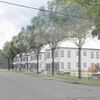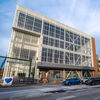Getting there from here | As transportation costs mount, a shift to public transit could be the answer for Maine
“Charting the course” is written by GrowSmart Maine, a Yarmouth nonprofit with a mission to promote and encourage new ideas and new ways of thinking about Maine’s future. This issue’s column is written by Christian McNeil, GrowSmart’s communications director.
These are fascinating times for transportation in Maine, and in America.
Gasoline prices exceeded $4 a gallon this summer and are widely expected to go even higher in coming years. Skyrocketing shipping costs are challenging the conventional “world is flat” wisdom of global trade. Detroit’s SUV manufacturing plants have morphed from cash cows to albatrosses, and declining auto use is drying up funding for road and bridge repair.
Our state and federal transportation agencies need to adapt to these changes before they are overwhelmed by them. For decades, departments of transportation have relied on steadily increasing gasoline consumption and gas tax revenues to pay for an expanding network of roads and highways. But suddenly, gas tax and toll revenues are plunging because people are driving less: In June, Maine motorists drove 7% fewer miles than they did in June 2007, and with the trend toward more fuel-efficient vehicles, revenues from the state’s fuel tax are declining even faster.
At the same time, costs of construction and pavement are soaring: The price of liquid asphalt rose 250% between January and August this year. Thousands of potholes across the state attest to the fact that the state doesn’t have enough money to adequately maintain the infrastructure we already have, much less pay for new roads or highways.
We have clearly come to the end of an era in which new roads were the answer to every transportation question. Just as large corporations like General Motors reexamine their business models and practices, we need to work quickly to find creative solutions and reinvent the way we invest in our transportation infrastructure.
More buses, fewer bills
Washington is expected to produce a federal transportation funding bill sometime next year, and most observers expect it will initiate a major shift in American transportation funding for things like high-speed rail, intermodal freight ports and public transportation.
Maine’s transportation agencies need a similar transformation. The new long-range transportation plan of the Maine Department of Transportation proposes spending $4.2 billion on highways and bridges in the next 10 years. That’s 10 times more money than MDOT proposes to spend on transit, freight rail and ports. But a bigger problem is the fact that MDOT only expects to collect $3.2 billion in tax revenues during the same period.
If MDOT follows its current course, there will be only two ways to address this billion-dollar shortfall: Raise taxes and fees (MDOT’s choice) or neglect critical maintenance to our infrastructure.
Neither option is acceptable. Instead, Maine needs to commit to maintaining its existing infrastructure and invest its limited transportation funds more diversely and cost-effectively.
According to conventional wisdom, Maine is a rural state and transit can’t succeed here. In fact, more than a quarter of the state’s population lives in communities that already have regular bus or train service. Those services have been in high demand this year, and modest investments could make them convenient enough to serve many more commuters.
Getting out of the car
Granted, most Mainers will continue to rely on their cars for the foreseeable future. But many Mainers are also desperate for alternatives. Improving transit in Maine’s larger cities and towns will leave more money to keep roads in good condition throughout the rest of the state.
For example: The Maine Turnpike Authority and MDOT are currently proposing to spend a quarter billion dollars on expanded freeways in Greater Portland. According to the agencies’ own planning documents, though, commuter bus or rail service would do more to reduce congestion at a fraction of the cost. By buying a few buses instead of expensive new freeway lanes, Portland-area residents could save time and money in their daily commutes, and the rest of the state could save hundreds of millions of dollars.
We can’t wait for the changes we need to come from Augusta. Mainers need to engage their political leaders in a frank discussion of our infrastructure’s fiscal dilemmas, and the possibility of building a 21st-century transportation network in Maine.
We hope to begin that discussion on Oct. 10 at our annual Summit in Augusta, when Kate Rube, a spokeswoman for the Transportation for America coalition, will join us for a workshop on the future of transportation policy and how it relates to Maine’s fiscal and energy challenges. To learn more, visit www.growsmartmaine.org or www.t4america.org.
Christian McNeil can be reached at christian@growsmartmaine.org.










Comments